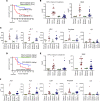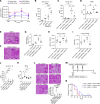BAM15 treats mouse sepsis and kidney injury, linking mortality, mitochondrial DNA, tubule damage, and neutrophils
- PMID: 36757801
- PMCID: PMC10065071
- DOI: 10.1172/JCI152401
BAM15 treats mouse sepsis and kidney injury, linking mortality, mitochondrial DNA, tubule damage, and neutrophils
Abstract
Sepsis pathogenesis is complex and heterogeneous; hence, a precision-medicine strategy is needed. Acute kidney injury (AKI) following sepsis portends higher mortality. Overproduction of mitochondrial ROS (mtROS) is a potential mediator of sepsis and sepsis-induced AKI. BAM15, a chemical uncoupler, dissipates mitochondrial proton gradients without generating mtROS. We injected BAM15 into mice at 0, 6, or 12 hours after cecal ligation and puncture (CLP), and these mice were treated with fluids and antibiotics. BAM15 reduced mortality, even after 12 hours, when mice were ill, and BAM15 reduced kidney damage and splenic apoptosis. Serial plasma and urinary mitochondrial DNA (mtDNA) levels increased after CLP and decreased after BAM15 administration (at 0 or 6 hours). In vitro septic serum proportionately increased mtROS overproduction and mtDNA release from kidney tubule cells, which BAM15 prevented. BAM15 decreased neutrophil apoptosis and mtDNA release; neutrophil depletion counteracted BAM15 benefits. Further, mtDNA injection in vivo replicated inflammation and kidney injury, which was prevented by BAM15. A large dose of exogenous mtDNA reversed protection by BAM15. We conclude that BAM15 is an effective preventive and therapeutic candidate in experimental sepsis and that BAM15 and mtDNA, a potential drug-companion diagnostic/drug-efficacy pair for clinical sepsis, are mechanistically linked via mtROS.
Keywords: Innate immunity; Mitochondria; Nephrology.
Conflict of interest statement
Figures








References
Publication types
MeSH terms
Substances
LinkOut - more resources
Full Text Sources
Medical
Miscellaneous

